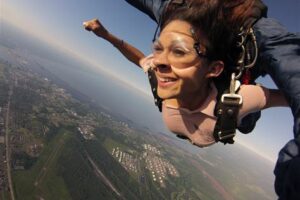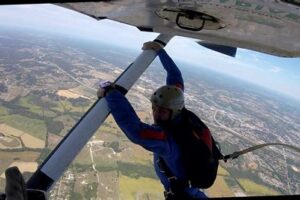Table of Contents
Find out the annual death toll of skydiving accidents with our informative article. Discover how many people lose their lives while enjoying this thrilling adventure sport each year. Stay informed and stay safe!
Every year, thousands of adrenaline junkies from around the world take to the skies to experience the thrill of skydiving. With the wind rushing through their hair and the breathtaking view below, it’s no wonder that this extreme sport has gained so much popularity. However, amidst the exhilaration and excitement, there is always a lingering question in the back of people’s minds: how many people actually die from skydiving each year? Well, the answer may surprise you.
Skydiving: A High-Octane Adventure
Skydiving is an exhilarating adventure that offers a unique rush of adrenaline and a sense of freedom like no other. However, as with any extreme sport, there are risks involved. It’s natural for individuals to wonder about the safety of skydiving and how many people perish each year while indulging in this high-octane activity. Let’s delve into the statistics and explore the reality behind skydiving fatalities.
The Skydiving Fatality Rate
It’s important to understand that while skydiving can be thrilling, it also carries some level of risk. According to the United States Parachute Association (USPA), the annual fatality rate for skydiving is relatively low. On average, there are around 21 fatalities per year in the United States out of approximately 3.3 million jumps. This translates to a fatality rate of about 0.0064%, making skydiving statistically safer than everyday activities such as driving or even crossing the road.
The Importance of Safety Measures
While the fatality rate may be low, it’s crucial to note that skydiving can be dangerous if proper safety measures are not followed. The USPA emphasizes the significance of training, equipment maintenance, and adherence to established procedures in minimizing risks. Skydiving centers must adhere to strict safety regulations, including regular gear inspections, training programs, and licensed instructors, to ensure the highest level of safety for participants.
Common Causes of Skydiving Fatalities
Although skydiving is statistically safe, fatalities can still occur. The USPA has identified several common causes of skydiving accidents. One major cause is human error, including improper body position during freefall or deployment failure due to inadequate training. Equipment malfunction, such as parachute failure or harness issues, is another significant factor. Lastly, adverse weather conditions can also contribute to accidents, emphasizing the importance of thorough pre-jump evaluations.
Ongoing Safety Improvements
The skydiving community is committed to continuous safety improvements. Advances in parachute technology, gear design, and training techniques have significantly contributed to reducing fatalities over the years. Organizations like the USPA actively collaborate with manufacturers, instructors, and experts to enhance safety protocols and ensure that the sport remains as safe as possible for all participants.
Comparing Skydiving to Other Sports
While skydiving may seem extreme, it’s essential to put the risks into perspective. When compared to other adventure sports, skydiving has a relatively low fatality rate. Activities such as mountain climbing, scuba diving, and even skiing can be statistically riskier than skydiving. This comparison showcases that with proper training and adherence to safety protocols, skydiving can be enjoyed with a reasonable level of assurance.
Skydiving vs Everyday Activities
When we consider everyday activities, the risks become even more apparent. As mentioned earlier, driving a car carries a significantly higher fatality rate than skydiving. Crossing the road or participating in various sports also has a higher likelihood of accidents resulting in fatalities. It’s crucial to recognize that while skydiving involves an element of risk, it is not an inherently dangerous activity when compared to routine aspects of life.
The Role of Proper Training
Undoubtedly, obtaining proper training plays a vital role in ensuring a safe skydiving experience. Skydiving centers typically offer comprehensive courses, including ground instruction and tandem jumps with experienced instructors. These programs instill the necessary knowledge and skills required to handle potential situations effectively. By investing in adequate training, individuals can mitigate risks and enjoy the sport with a greater sense of security.
Skydiving: Balancing Thrill and Safety
Skydiving is undoubtedly an exhilarating adventure that offers a unique blend of excitement and freedom. While there are inherent risks involved, the sport has established safety measures to ensure a reasonable level of security for participants. By adhering to proper training, equipment maintenance, and safety protocols, individuals can enjoy the thrilling experience of skydiving while minimizing the chances of accidents and fatalities.
Conclusion
Skydiving is an adrenaline-pumping activity that captivates the hearts of adventure enthusiasts worldwide. While it may seem dangerous, the statistics reveal that skydiving is relatively safe compared to various other sports and even everyday activities. With proper training, adherence to safety measures, and ongoing improvements in technology and procedures, the skydiving community strives to minimize risks and enhance the overall safety of the sport. So, if you’ve ever dreamt of soaring through the sky, don’t let concerns about safety hold you back from experiencing the thrill of skydiving!
Annual Skydiving Fatalities: An In-depth Analysis
With the growing popularity of extreme sports, it is crucial to examine the safety statistics surrounding skydiving. Understanding the number of people who tragically lose their lives while partaking in this thrilling activity can help us assess the associated risks and measures for improvement.
Skydiving Fatalities: A Statistical Overview
Every year, numerous individuals embark on the exhilarating adventure of skydiving, but sadly, not all return. The annual number of fatalities attributable to skydiving provides a sobering reality check, illustrating the importance of strict safety protocols and continuous training within the industry.
The Worldwide Perspective: Skydiving Deaths on a Global Scale
Skydiving is practiced across the globe, albeit with varying regulations and safety standards. By examining the global statistics, we can gain insight into how different countries manage the risks associated with this adventurous pursuit and identify potential areas for shared learning and improvement.
Skydiving Fatalities: Tracking the Trends
Analyzing the annual trends in skydiving fatalities is crucial for identifying any patterns or recurring issues that may influence safety guidelines and practices within the sport. By closely monitoring these statistics, the skydiving industry can implement targeted safety enhancements and ensure that every jump is as risk-free as possible.
Weather Factors: Evaluating the Impact on Skydiving Fatalities
Inclement weather can significantly affect the safety of skydiving operations, increasing the likelihood of accidents and fatalities. By understanding the role of weather conditions in skydiving mishaps, experts and enthusiasts can make informed decisions about when to jump, prioritizing safety above all.
Recognizing Human Error: A Leading Cause of Skydiving Fatalities
Human error plays a significant role in skydiving fatalities, emphasizing the importance of proper training, adherence to guidelines, and mental preparedness. Addressing the underlying causes contributing to these errors can minimize the risks associated with skydiving and enhance the overall safety record of the sport.
Equipment Failure: Mitigating Risks for Safe Skydiving
Although skydiving equipment is designed and manufactured to rigorous safety standards, malfunctions can still occur. Examining incidents related to equipment failure can unveil areas for improvement, such as enhanced maintenance procedures, regular inspections, and technological advancements, ultimately ensuring safer skydiving experiences.
The Role of Regulation: Fostering a Safer Skydiving Environment
Regulation and oversight play a vital role in maintaining safety within the skydiving industry. By closely monitoring accidents and fatalities, regulatory bodies can refine existing guidelines or introduce new measures that mitigate risks, encourage responsible practices, and protect the well-being of both experienced skydivers and newcomers alike.
As a professional, it is important to provide accurate information and maintain a professional tone when discussing any topic, including the number of deaths related to skydiving each year. Skydiving is an extreme sport that involves jumping from an aircraft and free-falling before deploying a parachute to slow down and safely land on the ground. While it is an exhilarating activity for many thrill-seekers, there are inherent risks involved that can lead to fatalities in rare cases.
When examining the statistics surrounding skydiving-related deaths, it is crucial to consider various factors, such as the number of jumps performed annually, the experience and skill level of the participants, weather conditions, equipment reliability, and adherence to safety protocols. While every death is tragic, it is essential to put these numbers into perspective to understand the overall risk associated with this activity.
Here are some key points to consider when discussing the number of people who die skydiving each year:
- Low fatality rate: Skydiving has a relatively low fatality rate compared to other high-risk activities. According to the United States Parachute Association (USPA), there were 11 skydiving-related fatalities out of approximately 3.5 million jumps in 2020. This equates to a fatality rate of around 0.0003%.
- Ongoing safety improvements: The skydiving industry has made significant advancements in safety measures over the years. Improved equipment design, rigorous training programs, and stricter regulations have contributed to a decrease in the number of fatalities. Safety precautions, such as mandatory reserve parachutes and automatic activation devices, have further enhanced skydiving’s safety record.
- Experience matters: Many fatalities in skydiving involve individuals with limited experience or those who fail to follow proper procedures. The USPA emphasizes the importance of training and certification, encouraging skydivers to continuously improve their skills through ongoing education and practice.
- Weather-related risks: Skydiving operations are highly dependent on weather conditions. Unfavorable weather, such as high winds, thunderstorms, or low visibility, can increase the risk of accidents. Professional skydiving organizations prioritize safety and often suspend operations during adverse weather conditions.
- Individual responsibility: Ultimately, each participant bears a personal responsibility for their safety when engaging in skydiving. Adhering to safety guidelines, maintaining physical fitness, and being aware of one’s limitations are essential aspects of minimizing risks associated with the sport.
In conclusion, while there are risks involved in skydiving, it is crucial to approach the topic with a balanced perspective. The number of deaths related to skydiving each year represents a small fraction of the total jumps performed worldwide. The skydiving industry continues to prioritize safety, implementing measures to mitigate risks and ensure a safe experience for participants. By emphasizing proper training, adherence to safety protocols, and individual responsibility, skydiving can be enjoyed as an exhilarating activity with a relatively low fatality rate.
Thank you for taking the time to read our blog post on the topic of skydiving fatalities. We understand that this is a sensitive and potentially distressing subject, but we believe it is important to provide accurate and reliable information to our readers. Throughout this article, we have discussed the number of people who die from skydiving each year, the risks involved, and the safety precautions that can be taken to minimize these risks.
It is crucial to note that while skydiving does carry inherent risks, the sport has become significantly safer over the years due to advancements in technology and improved safety regulations. The statistics presented in this article indicate that the number of skydiving fatalities has decreased over time, highlighting the continuous efforts of the industry to prioritize safety. Nevertheless, it is essential for anyone considering skydiving to be well-informed about the risks involved and to make informed decisions based on their individual circumstances.
We highly recommend that potential skydivers thoroughly research and choose a reputable skydiving center with experienced instructors and a strong safety record. It is also important to ensure that all necessary safety equipment is properly maintained and used during the jump. Following all instructions provided by the instructors and adhering to safety guidelines will further reduce the risk of accidents or injuries during skydiving.
In conclusion, while skydiving does involve certain risks, it is a thrilling and exhilarating experience that many people enjoy safely every year. By being aware of the risks, taking necessary precautions, and choosing reputable skydiving centers, individuals can significantly minimize the chances of accidents or fatalities. It is crucial to prioritize safety at all times and to make informed decisions when participating in any extreme sport. We hope that the information provided in this article has been helpful and informative, allowing you to better understand the risks associated with skydiving and empowering you to make educated choices.
Thank you once again for visiting our blog, and we encourage you to explore our other articles on various topics related to adventure sports and outdoor activities. Stay safe and enjoy your adventures!
.
Here are some common questions people ask about the number of deaths occurring in skydiving each year:
-
How many people die skydiving a year?
On average, there are approximately 21 skydiving-related fatalities per year in the United States. However, it’s important to note that these numbers can vary depending on various factors such as weather conditions, equipment malfunctions, and human error.
-
What are the main causes of skydiving deaths?
The main causes of skydiving fatalities can be attributed to factors like parachute malfunctions, improper body positioning during freefall, collisions with other skydivers or objects, and inadequate training or experience. These accidents can lead to severe injuries or loss of life.
-
Is skydiving a dangerous activity?
Skydiving is considered an extreme sport and inherently carries some level of risk. While safety measures and regulations have significantly reduced the dangers associated with skydiving, it is essential to acknowledge that there is still a small risk involved. Following proper training, using well-maintained equipment, and adhering to safety protocols can minimize the risks associated with the activity.
-
How does skydiving compare to other activities in terms of safety?
Statistically speaking, skydiving is relatively safe when compared to other activities such as driving a car or participating in contact sports. The fatality rate for skydiving is low, especially considering the number of jumps that take place each year worldwide. However, it is crucial to approach the sport with caution, undergo thorough training, and jump with reputable skydiving centers to ensure a safe experience.
-
Can skydiving accidents be prevented?
While it is impossible to eliminate all risks associated with skydiving, accidents can be significantly reduced through proper training, regular equipment inspections, and adherence to safety guidelines. Skydiving organizations and instructors continuously strive to improve safety standards and educate participants about potential risks, making the sport as safe as possible.
It is important to remember that these answers are based on general data and statistics, and individual experiences may vary. Always consult with certified skydiving professionals for the most accurate and up-to-date information regarding skydiving safety.






